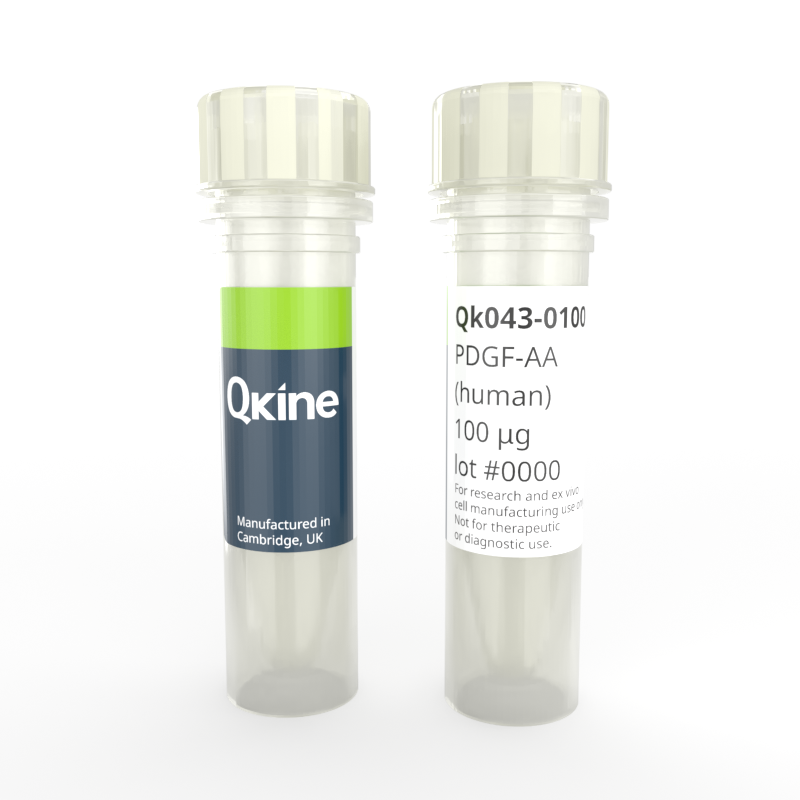Recombinant human PDGF-AA protein
QK043
Brand: Qkine
Human PDGF-AA (platelet derived growth factor AA) protein is a homodimer of PDGF-A peptide chains. PDGF-AA is commonly used to differentiate human pluripotent stem cell (hPSC)-derived neural progenitor cells into oligodendrocyte precursor cells.
Qkine human PDGF-AA is a high purity 29 kDa disulfide–linked bioactive dimeric protein, animal origin-free (AOF) and carrier protein-free.

Currency:
| Product name | Catalog number | Pack size | Price | Price (USD) | Price (GBP) | Price (EUR) |
|---|---|---|---|---|---|---|
| Recombinant human PDGF-AA protein, 25 µg | QK043-0025 | 25 µg | (select above) | $ 280.00 | £ 205.00 | € 240.00 |
| Recombinant human PDGF-AA protein, 50 µg | QK043-0050 | 50 µg | (select above) | $ 410.00 | £ 305.00 | € 357.00 |
| Recombinant human PDGF-AA protein, 100 µg | QK043-0100 | 100 µg | (select above) | $ 620.00 | £ 455.00 | € 532.00 |
| Recombinant human PDGF-AA protein, 500 µg | QK043-0500 | 500 µg | (select above) | $ 2,500.00 | £ 1,840.00 | € 2,150.00 |
| Recombinant human PDGF-AA protein, 1000 µg | QK043-1000 | 1000 µg | (select above) | $ 3,950.00 | £ 2,900.00 | € 3,388.00 |
Note: prices shown do not include shipping and handling charges.
Qkine company name and logo are the property of Qkine Ltd. UK.
Alternative protein names
Species reactivity
human
species similarity:
mouse – 95%
rat – 95%
porcine – 89%
bovine – 91%
Alternative(s)
Summary
- High purity human PDGF-AA protein (Uniprot: P04085)
- 29 kDa
- >98%, by SDS-PAGE quantitative densitometry
- Expressed in E. coli
- Animal origin-free (AOF) and carrier protein-free
- Manufactured in our Cambridge, UK laboratories
- Lyophilized from acetonitrile, TFA
- Resuspend in sterile-filtered water at >50 µg/ml, add carrier protein if desired, prepare single use aliquots and store frozen at -20 °C (short-term) or -80 °C (long-term).
Featured applications
- Differentiation of neural progenitor cells into oligodendrocyte precursor cells
Bioactivity
PDGF-AA activity is determined using the CellTiter-Glo (Promega) luminescence assay in Balb/c 3T3 cells. Cells are treated in triplicate with a serial dilution of PDGF-AA for 3 days. Cell viability is measured and normalized. EC50 = 183.3 pM (5.3 ng/mL). Data from Qk043 lot #104307.

Purity
PDGF-AA migrates as a single band at ~30 kDa in non-reducing (NR) conditions and ~15 kDa upon reduction (R). The additional faint lower molecular weight band in the reduced condition (R) is due to the harsh treatment required to fully reduce the disulfide linked dimer. Purified recombinant protein (3 µg) was resolved using 15% w/v SDS-PAGE in reduced (+β-mercaptothanol, R) and non-reduced (NR) conditions and stained with Coomassie Brilliant Blue R250. Data from PDGF-AA Qk043 batch #104307.

Further quality assays
- Mass spectrometry: single species with expected mass
- Analytical reversed-phase: single sharp peak
- Endotoxin: <0.005 EU/μg protein (below level of detection)
- Recovery from stock vial >95%
Protein background
Platelet derived growth factor (PDGF) is part of the PDGF/VEGR family. As the name suggests it is produced by platelets, and by several other cell types including endothelial cells, fibroblasts, vascular smooth muscle cells, osteoblasts, glia and neurons [1]. In platelets, PDGF is stored in α-granules, and released in response to platelet activation, leading to stimulation of epithelial cells.
PDGFs are dimers of PDGF-A, -B, -C or -D polypeptide chains, arranged in homodimers (eg PDGF-AA and PDGF-BB) or heterodimers (eg PDGF-AB). There are two receptors for PDGFs, PDGFR-α and PDGFR-β. PDGFR-α is a receptor for all PDGF dimers apart from PDGF-DD, while PDGFR-β is a receptor for PDGF-BB and PDGF-DD [2]. Activation of these receptors by PDGF leads to activation of downstream signalling pathways including PI3K, MAPK and STAT3 pathways [3]. PDGF plays an important role in embryonic development [4], cell proliferation, cell migration and angiogenesis. PDGF is a potent mitogen for cells of mesenchymal origin such as fibroblasts, glial cells and vascular smooth muscle cells.
PDGF-AA is commonly used to differentiate human pluripotent stem cell (hPSC)-derived neural progenitor cells into oligodendrocyte precursor cells [5].
Background references
- Demoulin, Jean-Baptiste, and Carmen P. Montano-Almendras. ‘Platelet-Derived Growth Factors and Their Receptors in Normal and Malignant Hematopoiesis’. American Journal of Blood Research, vol. 2, no. 1, Jan. 2012, pp. 44–56. https://www.ncbi.nlm.nih.gov/pmc/articles/PMC3301440/
- Kardas, Grzegorz, et al. ‘Role of Platelet-Derived Growth Factor (PDGF) in Asthma as an Immunoregulatory Factor Mediating Airway Remodeling and Possible Pharmacological Target’. Frontiers in Pharmacology, vol. 0, 2020. doi:10.3389/fphar.2020.00047.
- Demoulin, Jean-Baptiste, and Ahmed Essaghir. ‘PDGF Receptor Signaling Networks in Normal and Cancer Cells’. Cytokine & Growth Factor Reviews, vol. 25, no. 3, June 2014, pp. 273–83. doi:10.1016/j.cytogfr.2014.03.003.
- Andrae, Johanna, et al. ‘Role of Platelet-Derived Growth Factors in Physiology and Medicine’. Genes & Development, vol. 22, no. 10, May 2008, pp. 1276–312. doi:10.1101/gad.1653708.
- Major, Tamara, et al. ‘Derivation of Telencephalic Oligodendrocyte Progenitors from Human Pluripotent Stem Cells’. Current Protocols in Stem Cell Biology, vol. 39, Nov. 2017, p. 1H.10.1-1H.10.23. doi:10.1002/cpsc.17.